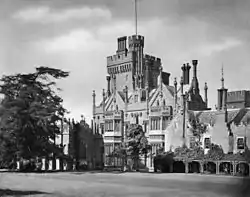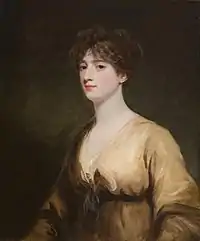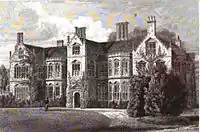George Stafford-Jerningham, 8th Baron Stafford
George William Stafford-Jerningham, 8th Baron Stafford (27 April 1771 – 4 October 1851), known as Sir George William Jerningham, 7th Baronet from 1809 to 1824, was a British peer who, in 1824, successfully obtained a reversal of the attainder of the barony of Stafford.
The Lord Stafford | |
|---|---|
| Personal details | |
| Born | George William Jerningham 27 April 1771 |
| Died | 4 October 1851 (aged 80) |
| Spouse(s) | Frances Henrietta Sulyarde
(m. 1799; died 1832)Elizabeth Caton
(m. 1836; |
| Relations | Henry Dillon, 11th Viscount Dillon (grandfather) |
| Children | 12 |
| Parents | Sir William Jerningham, 6th Baronet Hon. Frances Dillon |
| Residence | Haughley Hall Costessey Hall |
Early life

Stafford was born on 27 April 1771. He was the son of eldest son, and heir, of the former Hon. Frances Dillon (1747–1825) and Sir William Jerningham, 6th Baronet (1736–1809) of Cossey Park in Norfolk.[1] His elder sister, Charlotte Georgiana Jerningham, was the wife of Sir Richard Bedingfeld, 5th Baronet. He had two younger brothers, William Charles Jerningham (one of his daughters married Edward Preston, 13th Viscount Gormanston and another married Sir Edward Charles Blount) and Edward Jerningham, a barrister who served as Secretary for British Catholic Board and designed the St. Augustine Chapel at the family seat, Costessey Hall, which opened the week after their father's death in 1809.[2] Edward married Emily Middleton of London in 1804, with whom he had four children.[3]
His father was the representative of one of the few remaining families of English Gentry prior to the Conquest, and was descended on his mother's side from King Edward III.[4] His paternal grandparents were Sir George Jerningham, 5th Baronet and the former Marie Françoise "Mary" Plowden (only surviving child of Mary Stafford-Howard and Francis Plowden, Comptroller of the Household James II and James III). His grandmother Mary was the sole heiress of her uncle, John Stafford-Howard, 4th Earl of Stafford (son of Hon. John Stafford-Howard of Stafford Castle, younger son of William Howard, 1st Viscount Stafford). His mother was the eldest daughter of Henry Dillon, 11th Viscount Dillon and the former Lady Charlotte Lee (second daughter of George Lee, 2nd Earl of Lichfield).[1]
Career
He succeeded as seventh Baronet of Costessey on 14 August 1809.[1] In 1824, he obtained a reversal of the attainder of the barony of Stafford (the attainder had been imposed on his ancestor William Howard, 1st Viscount Stafford and 1st Baron Stafford in 1680). The family assumed by Royal licence the additional surname of Stafford at the same time.[3]
In 1829, he was made a fellow of the Society of Antiquaries of London, a learned society founded in 1707.[1]
Personal life


Lord Stafford was twice married. His first marriage was on 26 December 1799 to Frances Henrietta Sulyarde (1776–1832), youngest daughter and co-heirss of Edward Sulyarde of Haughley Hall and the former Susanna Ravenscroft (eldest daughter and co-heiress of John Ravenscroft of Wykeham).[1] Before her death on 14 November 1832, they were the parents of six sons and six daughters, including:[5]
- Hon. Charlotte Georgina Stafford-Jerningham (1800–1876), who married Thomas Fraser, 12th Lord Lovat, in 1823.[1]
- Henry Valentine Stafford-Jerningham, 9th Baron Stafford (1802–1884).[1]
- Hon. Edward Stafford-Jerningham (1804–1849), who married Marianne Smyth (d. 1859), daughter of John Smythe, Esq., in 1828.[1]
- Hon. Sir George Sulyarde Stafford-Jerningham (1806–1874), who served as Envoy Extraordinary and Minister Plenipotentiary to Sweden from 1859 to 1872.[1]
- Hon. Charles William Stafford-Jerningham (1807–1884), a Lieutenant in the 6th Dragoon Guards who died unmarried.[1]
- Hon. Laura Maria Stafford-Jerningham (1811–1886), who married Hon. Robert Edward Petre MP, eldest son of Robert Petre, 9th Baron Petre and, his second wife, Juliana Barbara Howard (sister of Bernard Howard, 12th Duke of Norfolk), in 1829.[1]
- Hon. William George Stafford-Jerningham (1812–1874), who served as Minister Resident at Lima in Peru from 1857 to 1874 and who married Eglantina Narcissa Elmore, daughter of Frederick Augustus Elmore of Lima, in 1860.[1]
- Hon. Francis Hugh Joseph Stafford-Jerningham (1814–1874), who died unmarried.[1]
The couple lived at Haughley Hall until 1809 when he inherited his father's title and estate. They moved to the Jerningham family seat of Costessey Hall and lived there for the rest of their lives. Haughley Hall was sold to William Crawford in about 1816. From 1826 to 1836, J. C. Buckler built a Gothic castle at Costessey for Lord Stafford which was several times larger than the original Tudor hall.
After Frances' death in 1832, he married Elizabeth Caton (1790–1862), second daughter Richard Caton and Mary Carroll Caton (a daughter of Charles Carroll of Carrollton), on 26 May 1836.[1] One of her sisters, Marianne, was the second wife of Richard Wellesley, 1st Marquess Wellesley.[6] Another, Louisa, was the wife of Sir Felton Hervey-Bathurst, 1st Baronet and,[7] after his death, Francis D'Arcy-Osborne, 7th Duke of Leeds.[8] The youngest was Emily Caton, wife of John McTavish, the Scottish born British Consul at Baltimore.[9]
Lord Stafford died on 4 October 1851 and was buried at Cossey, Norfolk. He was succeeded in the baronetcy and barony by his eldest son, Henry. Lady Stafford died eleven years later on 29 October 1862.[1]
Descendants
Through his second son Edward,[10] he was a grandfather of Augustus Stafford-Jerningham, 10th Baron Stafford (1830–1892), FitzHerbert Stafford-Jerningham, 11th Baron Stafford (1833–1913), Emily Charlotte Stafford-Jerningham (1835–1881), wife of Basil Thomas Fitzherbert (parents of Francis Fitzherbert-Stafford, 12th Baron Stafford and Admiral Edward Fitzherbert, 13th Baron Stafford),[11] and Rosa Stafford-Jerningham (1838–1880), who became a nun.[1]
References
- "Stafford, Baron (E, 1640)". www.cracroftspeerage.co.uk. Heraldic Media Limited. Retrieved 22 July 2020.
- Thomas, Grosvenor; Jerningham (bart.), Sir William; Stafford, Baron George William Stafford-Jerningham; Drake, Maurice (1920). The Costessey collection of stained glass: formerly in the possession of George William Jerningham, 8th baron Stafford of Costessey in the county of Norfolk. W. Pollard & Co., ltd. Retrieved 22 July 2020.
- Kidd, Charles, Williamson, David (editors). Debrett's Peerage and Baronetage (1990 edition). New York: St Martin's Press, 1990,
- Fraser, Antonia (2019). The King and the Catholics: England, Ireland, and the Fight for Religious Freedom, 1780-1829. Knopf Doubleday Publishing Group. p. 316. ISBN 978-0-525-56483-6. Retrieved 22 July 2020.
- Debrett's Peerage, Baronetage, Knightage and Companionage. 1878. p. 583. Retrieved 22 July 2020.
- Francis F. Beirne (October 1984). The Amiable Baltimoreans. JHU Press. pp. 111–. ISBN 978-0-8018-2513-2.
- "Hervey-Bathurst (UK Baronet, 1818)". www.cracroftspeerage.co.uk. Heraldic Media Limited. Retrieved 26 August 2019.
- "Leeds, Duke of (E, 1694 - 1964)". www.cracroftspeerage.co.uk. Heraldic Media Limited. Retrieved 26 August 2019.
- Wise, Marsha Wight (2006). Ellicott City. Arcadia Publishing. p. 79. ISBN 9781439617281. Retrieved 26 August 2019.
- Who's Who. A. & C. Black. 1910. pp. 659, 1917. Retrieved 22 July 2020.
- Connor, John (2014). The Inns and Alehouses of Stafford: Through the North Gate. Troubador Publishing Ltd. p. 5. ISBN 978-1-78306-425-0. Retrieved 22 July 2020.
External links
- Henry Valentine Stafford-Jerningham, 9th Baron Stafford (his son) at the National Portrait Gallery, London.
| Peerage of England | ||
|---|---|---|
| Preceded by William Jerningham de jure |
Baron Stafford 1809–1851 |
Succeeded by Henry Valentine Stafford-Jerningham |
| Baronetage of England | ||
| Preceded by William Jerningham |
Baronet (of Cossey) 1809–1851 |
Succeeded by Henry Valentine Stafford-Jerningham |